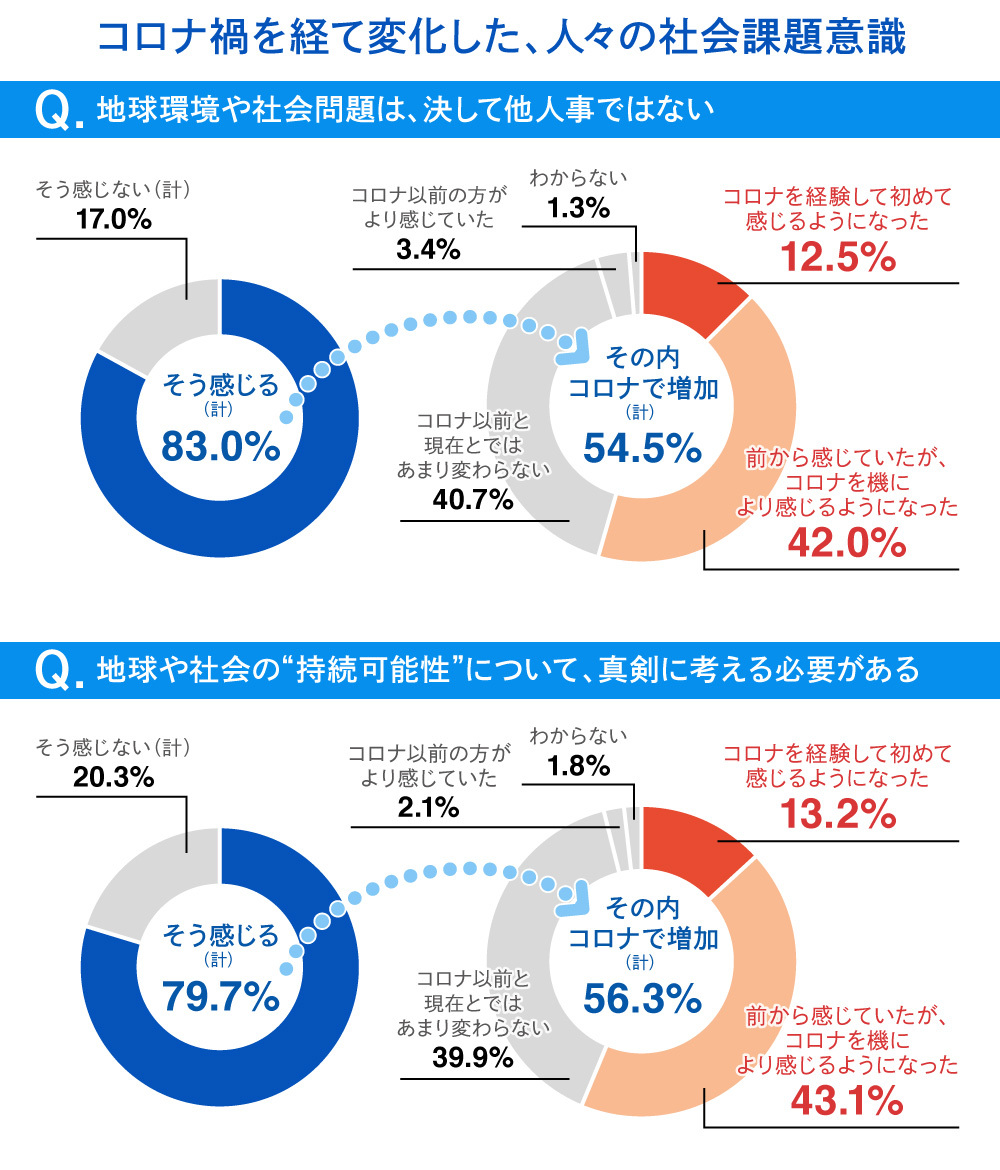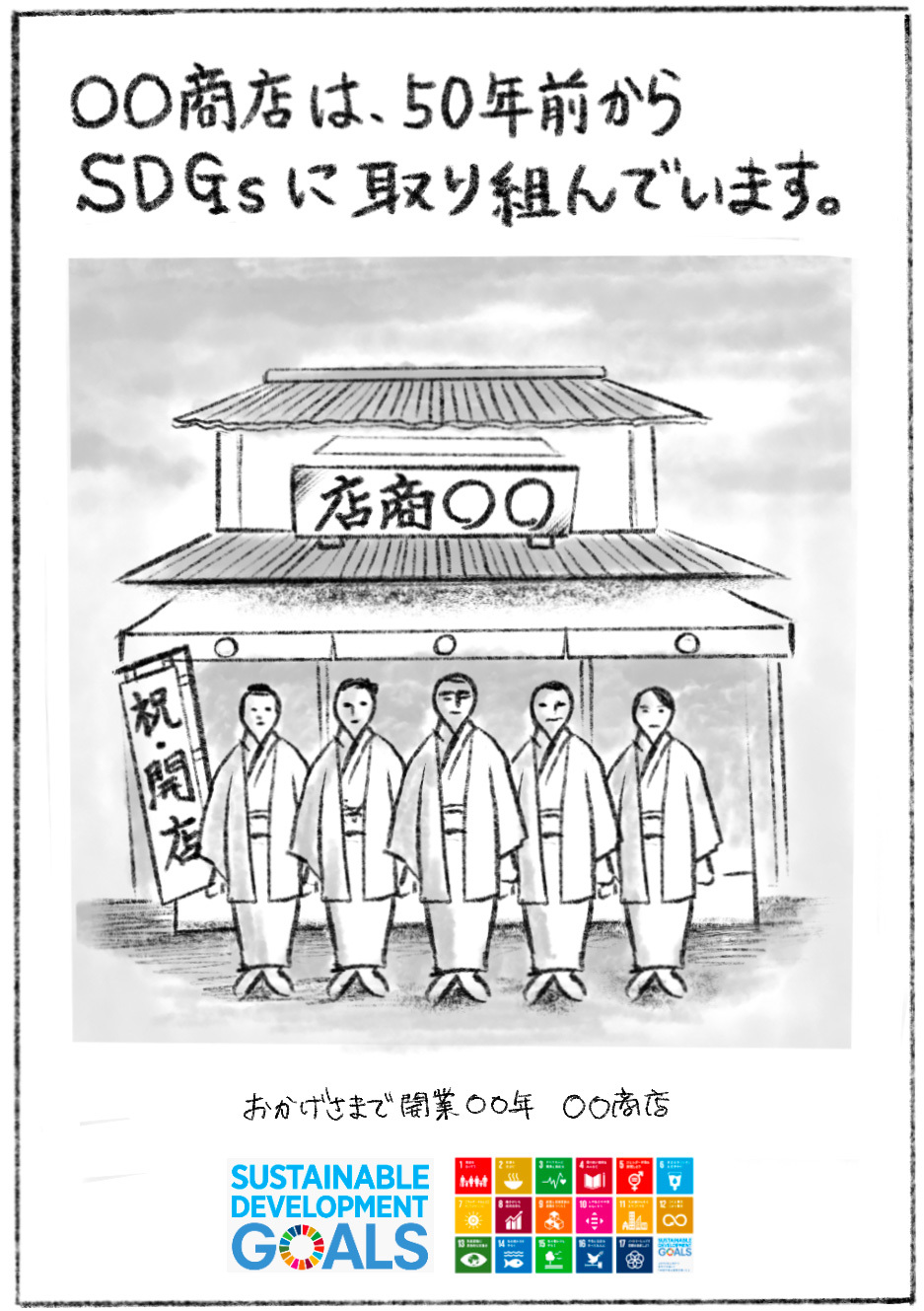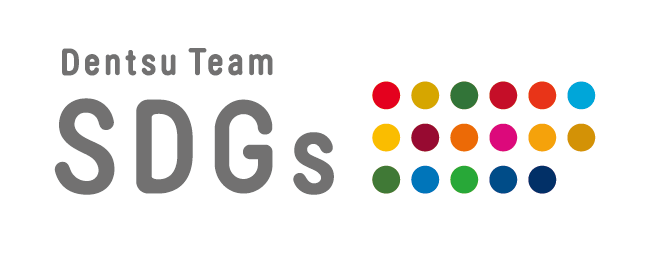Only 8 years remain until the SDGs deadline. Many companies are working towards achieving the SDGs and realizing a sustainable society. As consumer awareness of the SDGs rises and attitudes shift, the key points for communication between companies and consumers are evolving.
What should we focus on to achieve better communication? Yoko Oya from Dentsu Inc. Team SDGs, who worked on the 'Sustainability Communication Guide,' explains.
SDGs are moving from trend to next phase
The pandemic appears to be a major factor in the shift in public awareness regarding the SDGs. A Dentsu Inc. survey found that 83.0% of respondents feel "global environmental and social issues are by no means someone else's problem." Additionally, 79.7% answered that "we need to seriously consider the 'sustainability' of the planet and society." For both questions, over half of respondents reported that these feelings emerged for the first time after experiencing the pandemic ( see the survey article here ).

Source: "Survey on Awareness of 'Sustainability' and Corporate/Brand 'Purpose' (Social Aspirations/Social Significance)" (October 2020) ※Percentage figures are rounded to the nearest hundredth, so totals may not always add up to 100%.
According to the results of the " 5th Survey on SDGs Awareness Among Consumers" conducted by Dentsu Inc. Team SDGs in January 2022, awareness of the "SDGs" reached 86.0%, an increase of over 30 percentage points from the 4th survey in January 2021. Compared to the first survey conducted in February 2018, awareness has increased approximately sixfold. Responses indicating "understanding the content" also rose to 34.2%, about 1.5 times the previous survey. Among teenagers, this figure exceeded the majority.
These findings suggest that facing the shared global challenge of COVID-19 has made many people aware that it is no longer sufficient to think only about themselves or even just about Japan. The SDGs are not merely a trend; consumers are now scrutinizing corporate activities more than ever with the SDGs in mind. Consequently, companies are required to properly understand the essence of the SDGs and communicate information accordingly.
Beyond shifts in public consciousness due to the pandemic, the environment surrounding the SDGs has undergone significant changes in recent years. Currently, over 120 countries and regions worldwide have declared "carbon neutrality by 2050," accelerating the decarbonization movement. In 2020, movements like Black Lives Matter brought human rights issues into sharp focus.
Furthermore, rather than viewing the environment and human rights as separate issues, it is increasingly recognized that they are interconnected. Deteriorating environmental conditions can threaten the human rights of the people living in those areas.
For example, in 2021, a Dutch court ordered a top Dutch company to drastically reduce its CO2 emissions. The key point of this ruling was not merely demanding CO2 reduction, but stating that the climate change caused by increased CO2 constitutes a "human rights violation" against local residents. In the low-lying Netherlands, rising sea levels due to climate change could also lead to violations of property rights (human rights violations). This is why climate change is now considered a human rights issue. Issuing such a ruling against a leading domestic company required courage and represents a notable example of the global shift in understanding regarding the environment and human rights.
Communication between companies and consumers regarding SDGs is also evolving. Similarly in 2021, when an American beverage company launched an ad campaign promoting its sustainability credentials, environmental groups sued, citing evidence that the company's plastic waste had caused the world's worst pollution for three consecutive years. Society is now scrutinizing companies' actual practices.
As communication around SDGs and sustainability becomes more active, and consumer interest and literacy increase, the risk also rises that misguided perceptions or careless messaging will be perceived as "greenwashing" ( ).
Communicating your SDG efforts is essential in today's global society! Here are three key points you can't overlook
We've already passed the halfway point in our journey to achieve the SDGs by 2030. It's no longer a matter of "it's good to do," but rather a stage where "it's expected" and "not doing it is a disadvantage."
In Japan, some modest companies may engage with the SDGs without making a big announcement. However, in today's global society where companies are scrutinized from various angles, failing to communicate your efforts risks being perceived as "not committed to the SDGs." Furthermore, communicating your efforts helps increase understanding, attract co-creation partners, and build a fanbase.
So, what should companies focus on when communicating about SDGs? Dentsu Inc. Team SDGs revised and updated its "SDGs Communication Guide" issued in June 2018, publishing the "Sustainability Communication Guide" in December 2021.
This guide compiles key points for communicating with consumers about sustainability, including the SDGs, and considerations for advertising expressions. Here are some highlights:
・Before Starting Communication
Before initiating communication, we recommend first confirming whether your company's sustainability initiatives are fundamentally appropriate for the business and align with its scale and characteristics. Key points for preparation include ensuring the process involves diverse members and that activities are sustainable and envision meaningful social change unique to your company (i.e., activities that only your company can meaningfully undertake).
It goes without saying that addressing social issues relevant to the company, or those that only this company can solve, will resonate more strongly and be easier to communicate to consumers. Communication that embodies the company's distinct identity—making people think, "This company is pursuing these sustainability initiatives precisely because it is this company"—is more likely to resonate, be understood, and garner empathy. Conversely, if replacing the company name in a sustainability message with another company's name feels natural, it suggests the message lacks substance and could easily be made by any company. Pursuing what is "unique to your company" is crucial.
・When creating communication tools
When planning communication expressions, it's crucial to first clarify the company's "aspirations" for its activities. Messages that reveal the company's vision can make people think, "This company is great," potentially increasing supporters. This also connects to the company's "unique identity" and "distinctiveness" mentioned earlier.
Then, consider: Could this communication upset anyone? Is accessibility ensured (ensuring everyone can access the information and value provided)? Are we leaving anyone behind? Check and think about these points from multiple perspectives.
Furthermore, using exaggerated or vague language, pairing visuals unrelated to actual examples, or failing to adequately convey information about practices that actually exist... all of these can be perceived as "greenwashing."
Below are examples that could be perceived as "greenwashing."

The problems with this poster include, first, that the concept of SDGs did not exist 50 years ago. Furthermore, suggesting that if many people had been working on this 50 years ago, the current situation would not have arisen, could be seen as "arrogant" or "inappropriate." The SDGs are a global effort to solve problems that previous initiatives have failed to resolve. As clearly stated in the SDGs preamble, what is required is action to "transform the world."
Regarding the logo displayed at the bottom, since it is not the latest version, there is a risk that the company could be perceived as promoting SDGs while lacking proper understanding. Furthermore, if icons for specific goals are displayed, the company may be questioned about how it specifically contributes to each goal and what KPIs it has set. When displaying the SDGs logo, we strongly recommend verifying the UN guidelines to ensure the logo is current, aligns with all 169 targets (not just the 17 goals), and that there is no discrepancy with the messaging in your materials.
・After Production
Once your expression proposal is complete, it's crucial to have it reviewed by someone not involved in the production—ideally with a fresh, unbiased perspective—or by an expert. Dentsu Inc. Team SDGs' Expression Supervision Team receives many such requests, and effectively utilizing third-party organizations like this is a valuable approach. In communication, it's unfortunately possible for messages to be interpreted differently than intended. Preparing for potential inquiries—anticipating questions, formulating responses, and having quantifiable data ready—is also crucial for swift handling of any issues.
To prevent communication "accidents," please review the points to note once more.
Corporate communication regarding sustainability is expected to accelerate further in the future. However, knowing how to apply the "brakes" is crucial before stepping on the "accelerator." In a sense, this guide could also be seen as a manual on when and how to effectively apply the brakes to prevent unexpected "accidents."
We sincerely hope you will utilize this guide to further advance the increasingly demanded "sustainability communication."
As societal conditions change, the standards for "what should be done" evolve. This guide is by no means a final version; we aim to adapt it to the times, incorporate diverse perspectives, and refine it into a practical resource that truly works.
"Sustainability Communication" is not limited to advertising. It encompasses all information presented to the public, including statements by representatives at seminars and symposiums, store design and product packaging, articles published on company websites, and communications via social media. We hope it will be read and understood not only by those responsible for advertising and public relations, but also by a wide range of professionals, including those in research and development, marketing, and sales.
Download the "Sustainability Communication Guide" here!
・Japanese Version
・ English Version

A project team promoting SDGs from a business perspective. We support corporate activities to realize a sustainable society through consulting and product/service development. Additionally, we conduct various surveys on SDGs and sustainability, and produce tools like the "Sustainability Communication Guide" and "SDGs Hint Map." Our owned media " TeamSDGs " also shares diverse insights.







